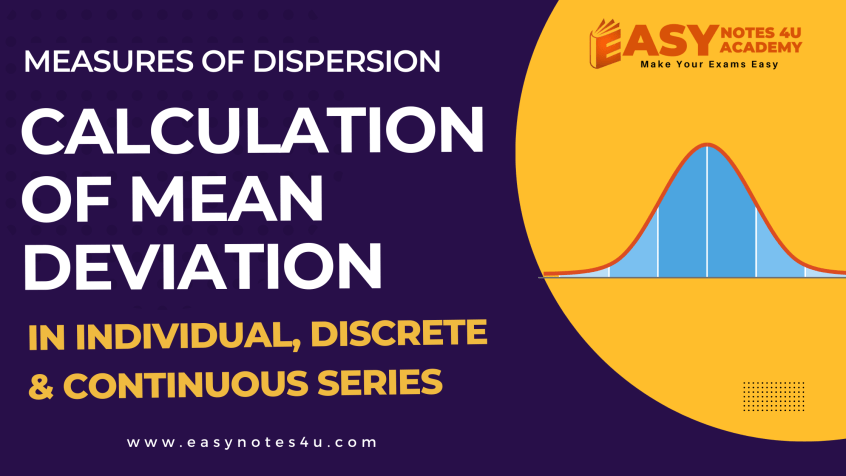
Calculation of Mean Deviation in Individual, Discrete & Continuous Series | How to Calculate Mean Deviation | Measures of Dispersion | Statistics
What is Mean Deviation – Measures of Dispersion, Statistics?
The arithmetic average of the deviations of various items from a measure of central tendency (mean, median, or mode) is known as the Mean Deviation of a series. Other names for Mean Deviation are the First Moment of Dispersion and Average Deviation.
Mean deviation is calculated by using all of the items in the series. Mean deviation can theoretically be calculated by taking deviations from any of the three averages. However, in reality, either the mean or the median is used to determine the mean deviation. Mode is usually not considered because its value is uncertain and provides incorrect results. Since the sum of deviations from the median is less than the sum of deviations from the mean, the former is considered better than the latter.
Note: The sign (+ or -) of deviations is ignored while calculating deviations from the selected average, assuming all deviations are positive.
How to Calculate Mean Deviation
Calculation of Mean Deviation – Measures of Dispersion
1. Individual Series
Calculation of Mean Deviation in Individual Series
Calculation of Mean Deviation in Individual Series | Measures of Dispersion Statistics – When calculating the mean deviation for an individual series, the deviations from the mean or median are added together. The sum is then divided by the number of items in the series.
Steps for Calculation of Mean Deviation in Individual Series
- Determine the specific average (Mean or Median) from which the mean deviation will be calculated.
- Determine the absolute (positive) deviations of all observations from the specific average.
- Then the absolute deviations are added together to find out Σ|D|
- Apply the formula:
Example:
How to Calculate Mean Deviation – Calculate mean deviation from mean and median for the given data: 10, 18, 21, 32, 44
Solution:
Mean Deviation from the Mean

Mean = 25
Mean Deviation from Mean = 10.4
Mean Deviation from the Median
= Size of 3rd item
Median = 21

Mean Deviation from Median = 9.6
2. Discrete Series
Calculation of mean deviation in Discrete Series
How to Calculate Mean Deviation | Steps for calculation of mean deviation in Discrete Series | Measures of Dispersion | Statistics
- Determine the specific average from which the mean deviation will be calculated.
- Determine each observation’s absolute (positive) deviation from the specific average, or |D|.
- Multiply the absolute deviations |D| by the respect frequencies (f) to obtain the sum of products to get Σf|D|
- To calculate the mean deviation, divide Σf|D| by the number of items.
Example:
Calculation of mean deviation in Discrete Series – Calculate the mean deviation from the mean and median for the following distribution.
Solution:
Calculation of Mean Deviation from the Mean

Mean = 6.85
Mean Deviation from Mean = 0.82
Mean Deviation from the Median
= Size of 23th item
Median = 7
Mean Deviation from Median = 0.78
3. Continuous Series
Calculation of mean deviation in Continuous Series
How to Calculate Mean Deviation | Calculation of mean deviation in Continuous Series | Measures of Dispersion | Statistics – Mean deviation formulas for continuous series are the same as those for discrete series. The mid-points of class intervals must be determined for the given continuous frequency distribution and are taken as ‘m’. A continuous series takes on the shape of a discrete series in this way. All of the discrete series’ steps are then applied after that.
Example:
Calculation of mean deviation in Continuous Series | Measures of Dispersion | Statistics – Calculate the mean deviation from the mean and median for the following data:
Solution:
Mean Deviation from the Mean
Mean = 9.42
Mean Deviation from Mean = 3.59
Mean Deviation from the Median
= Size of 7th item
Therefore, the median lies in the group 8-12
l1 = 8, c.f. = 5, f = 4, i = 4
Median = 10
Mean Deviation from Median = 3.42
Discover more from Easy Notes 4U Academy
Subscribe to get the latest posts sent to your email.





